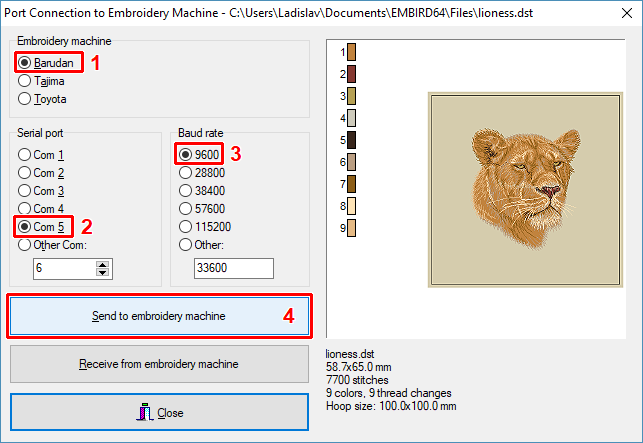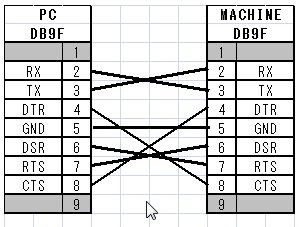- Tajima Serial Cable
- Tajima Serial Connection Diagram
- Tajima Serial Connection Tool
- Tajima Serial Connection Manual
- Tajima Serial Connection Software
EN is a European standard for material certificates. Based on a German standard, today there are four types of certificates under EN 10204. Type 3.2 certificates provide the most assurance of a material's properties.
It independently declare that the products or material supplied by a manufacturer meet the requirements of the buyer's order. While EN 10204 Type 3.2 material certificates have traditionally been required in the pressure equipment manufacturing sector in Europe, other geographies and industries are recognising the value of Type 3.2 certification. Many oil and gas equipment end users, for example, are now requiring Type 3.2 certification of material so they can be sure of the material's integrity. Type 3.2 certification helps give companies a new level of confidence as they cope with complex global supply chains. If buyers purchase material from stockists or material suppliers, only Type 3.1 certification may be available. If this is the case, true Type 3.2 certification is not possible. We do have a solution for these situations that helps address the main concern, which is independent assurance of the material.
This is done because the problem might have arisen due to a wrong connection of the RS232 cable. The fourth problem that is faced by many users of RS232 to RS485 ports is incorrect pin configuration, or finding it hard to deal with the serial ports' connector genders. This makes it hard for people to 'mate' or connect any devise that uses this. Move the frame manually so that the design fits in the embroidery area. . Works with serial interface turned off ^ Must use a powered USB hub, as the machines USB power output is not suffice for the device. # Some models require a USB HUB. Notes: Barudan machines may experience a slight delay when loading the designs on to the embroidery connect device.
We can provide 'intent-of' Type 3.2 certification. This can involve a visit to the material handler for material examination, as well as a visit to the test house to witness all additional testing of the material. Every situation is different. It is also important that the purchaser will accept this 'intent-of' Type 3.2 certification. As the manufacturer's independent third-party, we prepare the certificate. This means an LR surveyor is able to verify the material's identification and traceability through objective evidence, such as witnessing test results. We have a long history of independently verifying the properties of materials such as steel, going back now more than 100 years.
LR stands for indepenedence and integrity, with an eye toward the safety of society. As a result, manufacturers and end users around the world know they can trust a Type 3.2 certificate we've endorsed.
TAJIMA USB Linker 25pin Serial Cable TAJIMA USB Linker TAJIMA USB Linker Manual 7 Remarks: 1.The TAJIMA USB Linker package does not include an ACPlug Adaptor so please prepare at the customer side. 2.The location of Parallel/Serial port on Operation Panel is different, depending on themodels. Tajima Writer PLUS converts text to embroidery data, or creates embroidery data by combining registered designs and text. Editing tasks like changing the color of embroidery threads, position adjustments etc., and thread color management in synch with the machine are also possible.
Bs En 10204 Type 3.1 Pdf Free
BSEN 10204 test certificates for stainless steel products Introduction In Germany inspection documents (certificate types) were originally specified in standard DIN 50049. The definitions of material testing and certificate types in DIN 50049 was adopted for European standard EN 10204, first published in 1991. Certificate types 2.1, 2.2, 2.3, 3.1A, 3.1B, 3.1C and 3.2 were defined, closely following the definitions in the German standard. EN 10204 was revised in 2004 and published as BSEN 10204 in October 2004 with a simplified range of inspection documents (certificate types). These now only include types 2.1, 2.2, 3.1 and 3.2.
Bs En 10204 Type 3.1 Pdf Example
Type 2.3 has been deleted. Type 3.1 replaces 3.1B Type 3.2 replaces 3.1A, 3.1C and 3.2 of the previous edition. This reduced range of options should be easier to understand and work with. When this standard and certificate type is shown, it only refers to the certificate type and not the steel standard.
This should be covered separately eg BSEN 10088-2, for stainless steel sheet or plate type products Test certificate standards and types Each of the certificate types has a reference number, which has both its content and 'validation' requirements described in the standard in Appendix A, Table A.1. These descriptions are sometimes a little difficult to interpret and need some additional interpretation. The table below shows the full range of current (C) and withdrawn (W) EN 10204 certificate types, with some interpretation of what they cover. In any case of dispute however the descriptions given in Table A.1 of EN should be used. Certificate type Title Status Summary of EN10204 requirements Notes 2.1 Declaration of compliance with the order C Statement of compliance with the order by the manufacturer. No test results shown.
Bs En 10204 Type 3.1 Pdf 2
2.2 Test report C Statement of compliance with the order by the manufacturer based on non-specific inspections (tests) by the manufacturer. Like the old BS1449 'Cast Test' certificate. Mechanical test sample results from another coil from same cast, manufactured by the same process route, can be used. 2.3 Specific test report W With mention of test results from specific inspection and testing Batch test results needed on the certificate.
Difficult to distinguish this from the 3.1B type. 3.1 Inspection certificate C Statement of compliance with the order by the manufacturer with results of specific inspection Replaces 3.1B. Common certificate type issued for 'batch tested' material.
Issued and signed by manufacturer's representative, who must be independent of the manufacturing department. Eg Inspection department or test house manager/supervisor. 3.1A Inspection certificate 3.1A W With mention of test results from specific inspection and testing Batch test results. Issued by independent inspector required by releasing authority (eg TUV for German pressure vessels). Replaced by 3.2 in 2004 3.1B Inspection certificate 3.1B W With mention of test results from specific inspection and testing Batch test results. Issued and signed by manufacturer's representative. Replaced by 3.1 in 2004 3.1C Inspection certificate 3.1C W With mention of test results from specific inspection and testing Batch test results.
Issued by independent inspector appointed by customer (eg Lloyds). Replaced by 3.2 in 2004 3.2 Inspection certificate C Statement of compliance with order with indication of results of specific inspection Batch test results. Issued by both manufacturer's representative and an independent inspector appointed either by the customer (cf withdrawn 3.1C) or an inspector designated by official regulations (cf withdrawn 3.1A). Ie 3.2 now covers scope of both 3.1A and 3.1C of 1991 edition. This cover what is often referred to as 'outside inspection' When the 3.2 certificate type is requested the manufacturing mill may prepare a 3.1 type certificate to present to the 'outside inspector' to use as a basis for preparing the independent 3.2 certificate.
Only the 3.2 certificate is valid however for the ordered requirements and to match the product marking and inspectors stamp.
Machine Connections can be handled in a number of ways:
- If your embroidery machine comes with machine connection software, such as, Ricoma PC Communication Software (EMB_soft.exe) for Ricoma embroidery machine, or “Happy Link” software for Happy embroidery machine, etc., then “Connection Manager” is what you need. Please find out more information by clicking here.
- If your embroidery machine comes with a serial port but no machine connection software, please read the information below:
- Before you can send designs for stitching, you must configure the machine in EmbroideryStudio/DecoStudio. This configuration functionality allows you to add machines, change settings for machines that are already set up, or delete machines that are no longer required.
- EmbroideryStudio/DecoStudio provides alternative means for sending designs directly to the embroidery machine for stitching. Depending on your software options, you can stitch to the machine using either Stitch Manager or Machine Manager.

Your machine must be set up through Stitch Manager if you are sending to Stitch Manager, or Machine Manager if sending to Machine Manager.
The following information provides details pertaining to the protocols and settings required for EmbroideryStudio/DecoStudio to connect to embroidery machines.
Select your machine type:
Tajima | Barudan | Toyota | Brother | Happy | SWF | Ricoma | Cable Types
Tajima Machine Connections
Machine Type | Connection via | Details |
| Tajima machine with a Serial Port | Serial Cable: – Type Q (25 to 25 pin) – Type R (9 pin PC to 25 pin embroidery machine) | Port=COM1/COM2 Protocol=Standard Serial Baud=9600, or 38400 Data bits=8 Stop bits=1 Parity=None Handshaking=Hardware |
Barudan Machine Connections
Machine Type | Connection via | Details |
| Tanto, BEAT, BEVT, BEXY, BEXR | Serial Cable (9 pin) supplied by Barudan | Port=COM1/COM2 Protocol=Standard Serial Baud=9600, or 38400 Data bits=8 Stop bits=1 Parity=None Handshaking=Embroidery Machine |
| BEMS/R, BENS/R, BEZN, BEMAX, BEDS | Serial Cable (25 pin) supplied by Barudan | Port=COM1/COM2 Protocol=Standard Serial Baud=9600 Data bits=8 Stop bits=1 Parity=None Handshaking=Embroidery Machine |

Toyota Machine Connections
Machine Type | Connection via | Details |
| AD800/820/820A/830/850/860, ESP9000, ESP9100 | Serial Cable Type G, H, U, or V | Port=COM1/COM2 Protocol=Toyota Serial Baud=9600, or 38400 Data bits=8 Stop bits=2 Parity=Odd Handshaking=Hardware |
| Alternative settings for AD850/860 | Serial Cable Type G, H, U, or V | Port=COM1/COM2 Protocol=Toyota Serial Baud=9600, or 38400 Data bits=8 Stop bits=2 Parity=None Handshaking=Embroidery Machine |
Brother Machine Connections
Machine Type | Connection via | Details |
| Professional machines except 6-head | Serial Cable – Type H | Port=COM1/COM2 Protocol=Standard Serial Baud=9600 Data bits=8 Stop bits=1 Parity=None Handshaking=Embroidery Machine |
| Brother 6-head | Special Controller Board, Cable and Software from Brother | Not applicable |

Tajima Serial Cable
Happy Machine Connections
Tajima Serial Connection Diagram
Machine Type | Connection via | Details |
| HCG / HCG-B / HCA (controller HMS702C and HMS802) | Serial Cable: – Type G (25 to 25 pin) – Type U (9 pin PC to 25 pin embroidery machine) | Port=COM1/COM2 Protocol=Standard Serial Baud=9600 Data bits=8 Stop bits=1 Parity=None Handshaking=Embroidery Machine |
| HCS | Serial cable is supplied with the embroidery machine | Port=COM1/COM2 Protocol=Standard Serial Baud=38400 Data bits=8 Stop bits=1 Parity=None Handshaking=Hardware OR Embroidery Machine (both work) Machine Format=Happy or Tajima |
| HCD2 | Connection Manager via Happy LAN | Connection Manager |
| HCR2 | Connection Manager via Happy LAN or Happy Link | Connection Manager |
SWF Machine Connections

Machine Type | Connection via | Details |
| SWF machines with a Serial Port | Serial Cable – Type V (9 pin) | Port=COM1/COM2 Protocol=Standard Serial Baud=38400 Data bits=8 Stop bits=1 Parity=None Handshaking=Hardware |
Tajima Serial Connection Tool
Ricoma Machine Connections
Tajima Serial Connection Manual
Machine Type | Connection via | Details |
| Ricoma | Connection Manager via Ricoma PC Communication Software | Connection Manager |